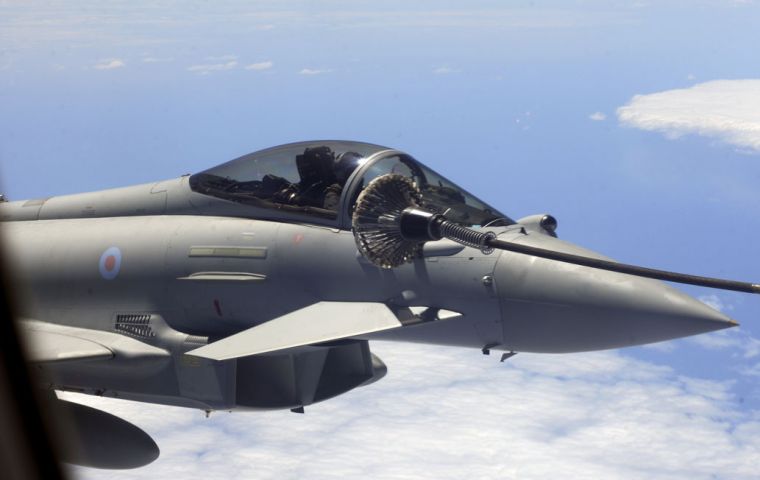MercoPress. South Atlantic News Agency
Typhoons were flown non-stop to the Falklands with support from ten aircraft
 Typhoons undergo air-to-air refuelling en route from Ascension Island to the Falkland Islands
Typhoons undergo air-to-air refuelling en route from Ascension Island to the Falkland Islands Senior officers from the Royal Air Force have paid tribute to squadrons across Britain following the successful deployment of four Euro-fighter Typhoons to the Falkland Islands.
Following one of the largest peacetime logistical missions of its kind, in the British Service’s history codenamed Operation TyphoonTempest Trail, four of the latest jets touched down in the South Atlantic after travelling 9,000 miles across the globe.
The aircraft, from 11 Squadron RAF Coningsby in Lincolnshire, replace the Tornado F3 fighters from RAF Leuchars in Fife, Scotland, which have completed 17 years service protecting UK interests on the other side of the world.
The touchdown at Mount Pleasant airbase marked the completion of months of planning and dedicated hard work.
“The extent of the challenge should not be underestimated,” said Squadron Leader Pete Morgan, an air-to-air refuelling specialist working for 2 Group at Air Command – the controlling authority for the operation.
“Not only was there a real requirement to deploy the Typhoons to replace the shortly-to-be-retired Tornado F3s, but the UK was also keen to demonstrate its continued ability to force project air power over strategic distances.”
In the event the Typhoon trail involved a total of ten support aircraft from four squadrons flying 280 hours supported by 95 personnel in addition to the fighters and their aircrews.
In a two-stage operation the aircraft were trailed by tankers to Ascension Island, using the Canary Islands as a staging post. From Ascension, they were trailed again to the Falkland Islands without any outside assistance.
Sqn Ldr Morgan said: “As a result, a complicated air-to-air refuelling plan was required with the Ascension to Falkland Islands leg being by far the most challenging.
“The Typhoons were accompanied by a TriStar aircraft throughout, whereas the other air-to-air assets provided fuel at various stages before returning to Ascension; in all, each Typhoon was required to refuel seven times.
“The Falkland Islands-based VC10 aircraft was on hand to provide a final top-up of fuel if required and to enable the Typhoons to divert to the South American mainland had the weather deteriorated unexpectedly during the nine-and-a-half hour transit.”
In addition, Hercules and Nimrod aircraft provided Search and Rescue cover for the long sea transits, and were equipped with survival equipment and spare life rafts that could be dropped to any survivors in the water in the event of an incident that necessitated the Typhoons ditching.
The extent of the back-up required to ensure a successful mission included: two TriStar aircraft from 216 Squadron, RAF Brize Norton in Oxfordshire, which flew a total of 89 hrs and involved 26 personnel; four VC10 aircraft from 101 Squadron, three of which are based at RAF Brize Norton, and one of which is based in the Falkland Islands. Between them, they flew some 87 hours and involved 28 personnel.
Three Hercules C130K aircraft from 70 Squadron, two of which are based at RAF Lyneham in Wiltshire, and one of which is based in the Falkland Islands. Between them, they flew 90 hours and involved 21 personnel.
One Nimrod MR2 from 120 Squadron, RAF Kinloss, in Forres, Morayshire, Scotland, which flew 14 hours and involved 20 personnel.
Throughout the mission, RAF 2 Group remained the controlling authority, with two highly experienced air-to-air refuelling coordinators planning and implementing the trail.
They travelled on the lead TriStar aircraft throughout, maintaining tactical control in the event of any in-flight incidents or emergencies.
Air Officer Commanding 2 Group Air Vice Marshall Steve Hillier said: “This was an impressive achievement across 2 Group involving Tristars, VC-10s, C-130s and a Nimrod MR2, as well as the command and control required to execute a complex air operation at range.
“An immense amount of effort was required by a large number of people, in the air and on the ground, and the whole operation was completed with an exemplary level of capability and professionalism. It was a clear demonstration of the RAF’s ability to exercise reach on a global scale,” he said.
Source and pictures: MoD/RAF




Top Comments
Disclaimer & comment rules-

-

-

Read all commentsTyphoons 30 minutes away from Tierra del Fuego...
Oct 26th, 2009 - 09:56 am 0typhoons wipe out half of Tierra del Fuego in 30 minutes. ha ha
Oct 26th, 2009 - 09:12 pm 0Now they are preparing to invade our antartic land and put another colony and wash their brains to make them believe the idea of selfdetermination 100 years later. This people is terrible!
Oct 27th, 2009 - 05:18 am 0Commenting for this story is now closed.
If you have a Facebook account, become a fan and comment on our Facebook Page!